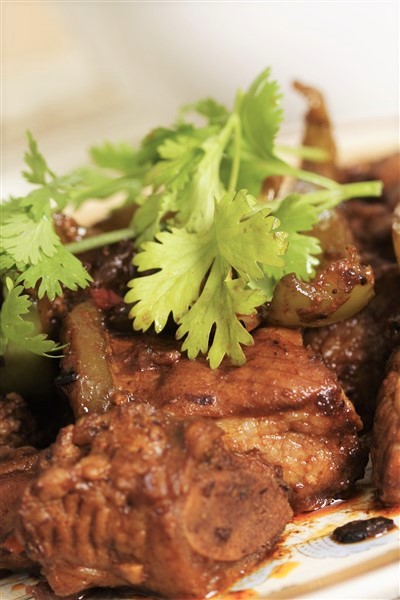Spared Ribs with Black Bean Sauce
Tender Spare Ribs in a Classic Sauce
This dish uses fried taro pieces as a base over which spared ribs (which have been marinated in black bean sauce) and other spices are laid. By steaming, the taro absorbs the thick meat juice and the tasty black bean sauce, making a rich, sticky spared ribs dish that is also tender and smooth. It is one of the most classic dim sum dishes found in Guangdong teahouses.

Ingredients
- 3.52 ounces (100 grams) taro
- 3.52 ounces (100 grams) spared ribs
Seasonings
- 1 red chili pepper
- 0.17 ounces (5 grams) black bean sauce
- 1/2 teaspoon (2 grams) salt
- 1/2 teaspoon (2 grams) chicken bouillon
- 1 heaping teaspoon (5 grams) sugar
- 1 teaspoon light soy sauce
- 1 teaspoon (5 grams) oyster sauce
- 1/2 tablespoon (5 grams) potato starch
- 0.1 ounce (3 grams) garlic
- enough cooking oil to grease the pan and drizzle on top of the ribs
- appropriate amount of water starch solution, enough to lightly cover the ribs
- appropriate amount of cooking wine
Cooking Directions
Preparations
- Peel and wash taro. Cut into small square pieces approximately 3/4 inch long. Peel garlic and wash. Mince. Mash black bean sauce. Wash red chili pepper and cut into circular strips.
- Wash spared ribs. Chop into small pieces approximately 3/4 inch long. Rinse repeatedly with water, then soak for approximately 30 minutes. Rinse away blood until meat whitens. Strain away excess water. Place in large bowl.
- Heat pan. Add a bit of cooking oil. Fry minced garlic and black bean sauce over low heat until aromatic. Remove and let cool to the side.
How to marinate the ribs
- Add light soy sauce, oyster sauce, cooking wine, salt, chicken bouillon, sugar, potato starch, and the garlic paste and black bean sauce from step 3 to spared ribs. Stir evenly. Refrigerate for approximately 30 minutes. Remove from refrigerator and add a bit of water and starch solution. Drizzle some cooking oil in. Mix.
How to prepare the taro
- Heat pan. Add appropriate amount of cooking oil. Bring oil to moderate temperature over medium heat. Add taro pieces. Reduce heat to medium and fry until taro's color changes. Remove and strain away excess oil.
Put it all together
- Lay out taro pieces on the bottom of a plate. Then lay an even layer of spared ribs over them. Place plate in a steamer basket.
- Add appropriate amount of water to steamer pot. After bringing to a boil over high heat, place steamer basket inside of steamer pot. Steam over low heat for approximately 15 minutes.
- Tip: Steaming over low heat will make the spared ribs more tender.
- Turn off heat. Leave steamer pot covered for approximately 3 minutes. Remove dish. Sprinkle red chili pepper strips on top and drizzle a bit of cooking oil to bring out the dish's color.
Taro and the Diet of a Monk
The taro in spared ribs with black bean sauce is an ingredient that is frequently seen in other Chinese dishes, such as fried sugar taro, taro cake, and dim sum crunchy taro fritters.
Traditionally, taro was a popular food among Buddhist monks and nuns. At Kaiyuan Temple in Fujian province, for example, monks and nuns there often used taro to make the sweet vegetarian dish "crispy pearl taro". "Red braised fish", meanwhile, which was made in South Putuo Temple, was made with taro that was carved into a fish shape. Buddhist practitioners also enjoyed taro cake, taro purée with pumpkin sauce, and peach blossom taro, which were other sweet vegetarian delights.